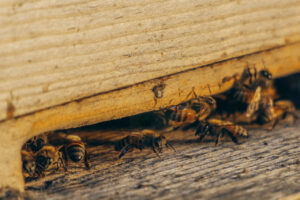In 1845, Ireland’s vast potato fields were struck by an invasive fungal disease that rapidly infested this staple crop. The effect was devastating.
One million people died of famine, and over a million more were forced to leave Ireland. Nowadays, we avoid such agricultural catastrophes with the help of pesticides. Those are a range of manmade chemicals that control insects,
unwanted weeds,
funguses,
rodents,
and bacteria
that may threaten our food supply.
They’ve become an essential part of our food system.
As populations have grown, monoculture, single crop farming,
has helped us feed people efficiently.
But it’s also left our food vulnerable to extensive attack by pests.
In turn, we’ve become more dependent on pesticides.
Today, we annually shower over 5 billion pounds of pesticides across the Earth
to control these unwanted visitors.
The battle against pests, especially insects,
has marked agriculture’s long history.
Records from thousands of years ago
suggest that humans actively burned some of their crops after harvest
to rid them of pests.
There’s even evidence from ancient times that we recruited other insects to help.
In 300 A.D., Chinese farmers specially bred ferocious predatory ants
in orange orchards to protect the trees from other bugs.
Later, as large-scale farming spread,
we began sprinkling arsenic, lead, and copper treatments on crops.
But these were incredibly toxic to humans as well.
As our demand for more, safer produce increased,
so did the need for effective chemicals
that could control pests on a grander scale.
This ushered in the era of chemical pesticides.
In 1948, a Swiss chemist named Paul Hermann Müller
was awarded a Nobel Prize for his discovery
of dichlorodiphenyltrichloroethane, also known as DDT.
This new molecule had unparalleled power to control many insect species
until the 1950s, when insects became resistant to it.
Worse, the chemical actually drove dramatic declines in bird populations,
poisoned water sources,
and was eventually found to cause long-term health problems in humans.
By 1972, DDT had been banned in the United States,
and yet traces still linger in the environment today.
Since then, chemists have been searching for alternatives.
With each new wave of inventions, they’ve encountered the same obstacle –
rapid species evolution.
As pesticides destroy pest populations,
they leave behind only the most resistant individuals.
They then pass on their pesticide-resisting genes
to the next generation.
That’s lead to the rise of super bugs,
such as the Colorado potato beetle,
which is resistant to over 50 different insecticides.
Another downside is that other bugs get caught in the crossfire.
Some of these are helpful predators of plant pests or vital pollinators,
so erasing them from agriculture wipes out their benefits, too.
Pesticides have improved over time
and are currently regulated by strict safety standards,
but they still have the potential to pollute soil and water,
impact wildlife,
and even harm us.
So considering all these risks, why do we continue using pesticides?
Although they’re imperfect,
they currently may be our best bet against major agricultural disasters,
not to mention mosquito-born diseases.
Today, scientists are on a quest for alternative pest control strategies
that balance the demands of food production
with environmental concerns.
Nature has become a major source of inspiration,
from natural plant and fungal chemicals that can repel or attract insects,
to recruiting other insects as crop bodyguards.
We’re also turning to high-tech solutions, like drones.
Programmed to fly over crops,
these machines can use their sensors and GPS
to carry out more targeted sprays
that limit a pesticide’s wider environmental impact.
With a combination of biological understanding,
environmental awareness,
and improved technologies,
we have a better chance of finding a holistic solution to pests.
Chemical pesticides may never shake their controversial reputation,
but with their help,
we can ensure that agricultural catastrophes
stay firmly in our past.



